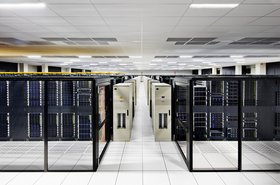For decades, industries of all types have worked towards building and designing machinery, tools and robots to carry out repetitive tasks with a high level of accuracy at high speeds, but also at lower cost, to deliver increased output. While this automation now dominates manufacturing and communications, running data centers has remained a human-centric task.
But that’s all about to change.
On CBRE’s podcast series “The Big Debate – Will Robots & AI replace humans in the Data Center?”, Zahl Limbuwala spoke to data center experts to gain their views. Where is the industry heading? What are the ramifications? And, how will the next generation of data centers be operated? And these are just some of the questions.
Limbuwala is Executive Director of Strategy for the CBRE’s Data Center Solutions practice, the largest outsourced operator of data centers in the world. In this featured episode of the podcast, Limbuwala is joined by Joseph Kava, Vice President of Data Centers at Google, to discuss how automation can replace humans in the data center and whether data centers are the information age factories.
Today we can bring you a little flavour of the discussion, in these exclusive extracts.
Zahl Limbuwala (ZL): Today, very little advanced technology is used within and for data center management. Most data centers still rely fairly heavily on local human labor, local human decision-making, and a simplistic level of automation and controls. Given your tenure in this industry and how you've seen it evolve, what are your thoughts around the future of data center operations and how it looks?
Joseph Kava (JK): I think that those key and cornerstone technologies that will enable a more automated future of data centers have been developing at an incredible rate recently. We're already successfully incorporating AI into our own data center operations, using DeepMind machine learning. As a result, we've been able to reduce the amount of energy for cooling by up to 40 percent. For any large-scale industrial manufacturing facility with a lot of energy consumption, this would be an amazing improvement, but for us it is especially pleasing given how far down the path of optimization Google was already with our own efficiency.
I think it's a phenomenal step forward. In 2020, we came to realize how important virtual presence technologies are, so we’ve doubled down on our use of Google Glass in the data centers for commissioning and troubleshooting in operations. We can bring subject matter experts from all around the world and let them see what I see in the data center. This has helped the operations team improve their ability to troubleshoot more quickly when people can’t be there to physically troubleshoot themselves.
As far as robotics, our hyperscale data centers are more like warehouses and most of the processes require a robot to navigate to a specific location to perform a task. Some of these technologies are in development right now – things like robot navigation, computer vision, motion planning and device tooling for what the robot will employ to do that operation… These have advanced exponentially over the last few years, however, even as advanced as the robotics have become, many of the tests in data centers are much more complicated than in other industries that have employed large scale robotic implementations.
So, while you don’t have to stretch the imaginations far to imagine a future where automation is responsible for a lot of the workload in a data center…the importance of the work done by humans cannot be overstated. After all, let us remember that humans can reason while automation only knows what it was programmed to do.
ZL: I certainly think CBRE has seen that acceleration as well…. we’ve established that there’s a place for advanced technologies within the guardrails of what they’re good at. However, we’ve also established that there is still a long path ahead of us for the data center's human operators, given all of the areas that require reasoning.
If we may just pivot to DCIM (data center infrastructure management), at one time, there were 80 or 90 companies providing some kind of DCIM. So, there were a lot of promises to assist operators with better levels of visibility and improved automation optimization, but they never quite lived up to those promises. Do you have a view as to why that is and, perhaps, whether AI and ML are taking up some of the slack that DCIM never fulfilled?
JK: You and I lived through this and I agree with you. There was a time you couldn’t attend a conference without a new DCIM solution that would enable the future of IT operations. I think the big problem is that if you look back even a few years, the distribution of compute infrastructure at the data center level was completely different than it is today.
For instance, new clusters that are deployed today have interconnect requirements that weren’t envisioned a few years ago. These things were not contemplated by DCIM systems that were developed even just a few years ago. They were typically built around constraint management and were programmed around the norms of the time. Many norms today break those conventional rules and the DCIM software hasn’t really been about to keep up.
Want to hear more? Then listen to the rest of this fascinating discussion on the CBRE Data Center feed on Spotify.
CBRE Data Center Solutions unlocks value and data center performance for clients, reducing risk through operational strategies powered by technology and talent.





